Choosing the right software development tools can make or break your project’s success. These tools are the pillars of efficient coding, seamless collaboration, and swift deployment, enabling agile teams to accelerate innovation, minimize errors, and deliver stellar software products that keep pace with market demands.
As we dive into 2024’s top software development tools, you’ll discover solutions that cater to various aspects of the development lifecycle — from planning and coding to testing and deployment. Among these, platforms like monday dev are revolutionizing how software development teams manage their entire product development process, offering a unified space for ideation, sprint management, and release coordination.
Let’s explore the tools shaping the future of software development and how they can propel your team to new heights of productivity and innovation.
What are software development tools?
Software development tools are specialized software applications, platforms, or services designed to assist software developers in creating, debugging, maintaining, and deploying software.
These tools encompass a wide range of functionalities, including:
- Code editors and integrated development environments (IDEs)
- Version control systems
- Project management and collaboration platforms
- Debugging and testing frameworks
- Deployment and continuous integration tools
The primary purpose of these tools is to streamline the software development process, enhance code quality, and improve team productivity. They provide developers with powerful features that automate repetitive tasks, facilitate code organization, and enable seamless collaboration among team members.
Learn more about software development lifecycle and agile development here.
Why use a software development tool?
Software development tools support developers through every phase of software creation — from coding and debugging to maintenance and deployment. Here’s why they’re critical:
- Enhanced efficiency: By automating routine tasks and refining complex workflows, these tools let developers focus on core coding and problem-solving, speeding up development cycles.
- Improved code quality: Features like syntax highlighting, code completion, and integrated testing ensure high standards are maintained, catching errors early.
- Seamless collaboration: With tools that support real-time collaboration and version control, teams can seamlessly work together, irrespective of their physical locations.
- Scalability support: As your software projects grow, the right tools adapt with you. They offer features like microservices architecture support, load testing, and scalable cloud deployments, ensuring your development process remains smooth regardless of project size.
- Innovation enablement: With AI-powered coding assistants, advanced analytics, and cutting-edge frameworks at your disposal, you can focus on pushing boundaries. These tools open up new possibilities, allowing you to concentrate on innovative solutions rather than routine tasks.
- Efficient deployment: Continuous integration and deployment tools help smooth the transition of code changes to production, ensuring reliability and reducing downtime.
- Insightful analytics: Advanced reporting tools help track progress, identify bottlenecks, and optimize development processes, ensuring decisions are data-driven.
As we explore the top software development tools of 2024, you’ll discover how each is uniquely poised to address these critical areas, empowering your team to excel.
Top 20 software development tools for 2024
Ready to supercharge your development process? Let’s dive into the cream of the crop — the top 20 software development tools making waves in 2024. From streamlining development workflows to boosting collaboration, these developer tools are designed to take your projects from good to great.
| Software | Best for | Starting pricing |
|---|---|---|
| monday dev | Complete product lifecycle management | $9/user/month |
| ClickUp | Task management and team collaboration | $5/user/month |
| GitHub | Version control and open-source collaboration | $4/user/month |
| Azure DevOps | End-to-end DevOps in Microsoft environments | $6/user/month |
| Jira | Agile project management and issue tracking | $7.75/user/month |
| Linx | Rapid backend development and process automation | Designer free; Server custom pricing |
| Bootstrap | Rapid, responsive front-end development | Free and open-source |
| Axure | Advanced prototyping and UX design | $29/user/month |
| Crimson Editor | Quick code editing and scripting | Free and open-source |
| UltraEdit | Advanced text editing and data manipulation | $79.95/year |
| Vim | Efficient text editing and programming | Free and open-source |
| Docker | Application containerization and microservices | $5/user/month |
| Codenvy | Cloud-based development and team collaboration | Custom pricing |
| Cloud9 | AWS-integrated development and serverless apps | No charge beyond AWS resource costs |
| SendBird | Implementing real-time chat and messaging | Custom pricing |
| Ato | AI-powered code completion and refactoring | $19/month |
| Visor | Visual project planning and resource management | $15/user/month |
| Bitbucket | Git repository management and CI/CD pipelines | $3/user/month |
| Nifty | All-in-one project management and team collaboration | $39/month for up to 10 users |
| JetBrains | Language-specific intelligent coding and debugging | $89 for the first year |
1. monday dev
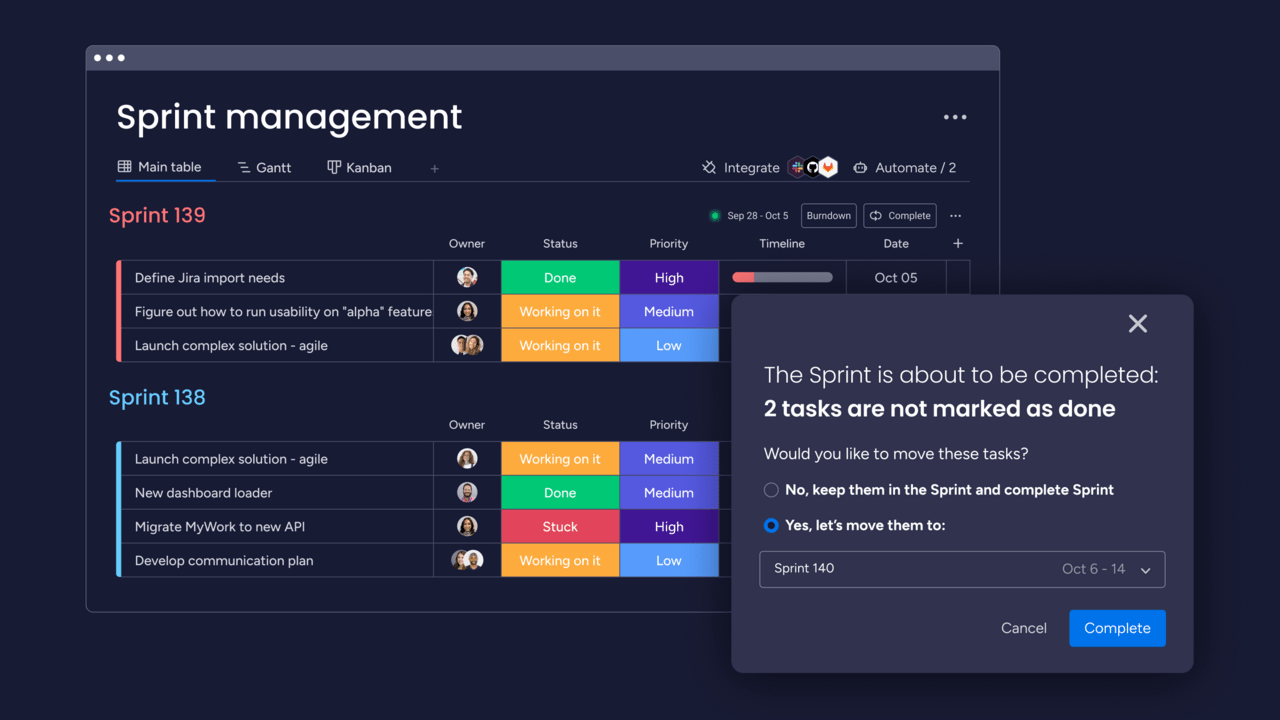
Imagine a world where your entire product development cycle flows seamlessly from ideation to launch. That’s the reality monday dev brings to the table. This powerhouse platform connects tech teams, leadership, and client-facing departments in one intuitive space with intuitive features, ensuring everyone’s on the same page — and loving every minute of it.
Best for: Full product lifecycle management
Key features of monday dev
- Seamless integrations with GitHub, GitLab, and Figma
- AI-powered sprint management and automations
- Advanced Kanban boards and burndown charts
- Customizable workflows to fit any development methodology
- Real-time bug and issue tracking software to spot the errors quickly
Pros of monday dev
- Accelerates time to market by streamlining the entire development process
- Boosts product quality through improved bug tracking and feedback loops
- Fosters innovation by connecting ideas with execution
- Enhances team alignment with clear, visual project and product roadmaps
- Increases visibility across departments, from dev to C-suite
monday dev pricing
monday dev cost depends on the plan you choose and your team size. Plans start from 3 users.
- $9/seat/month for Basic dev
- $12/seat/month for Standard dev
- $20/seat/month for Advanced dev
- Custom pricing available for enterprises to scale with your needs
- Free trial available to test-drive the platform
Want to see how monday dev can transform your development process? Check out our detailed pricing page and find the perfect plan for your team.
2. ClickUp
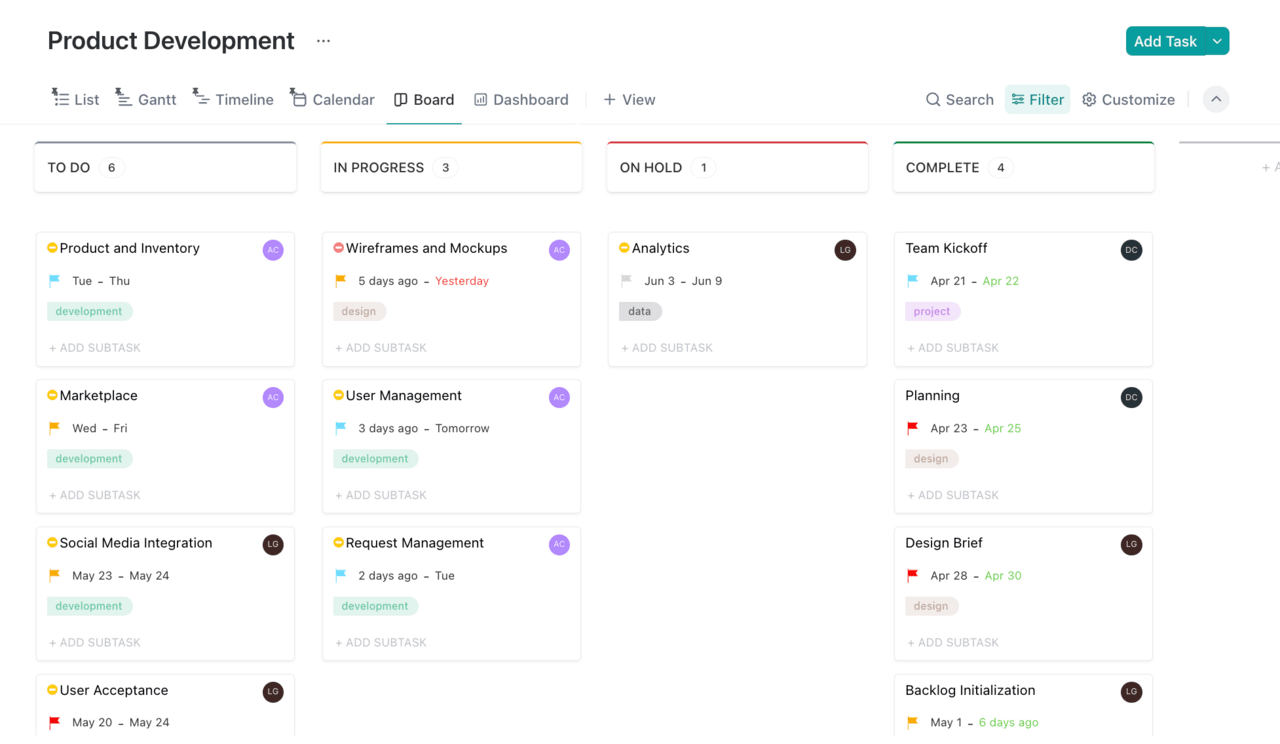
ClickUp positions itself as the all-in-one productivity platform, aiming to replace multiple tools with a single, versatile solution. It’s designed to help teams manage projects, tasks, and docs in one place.
Best for: Task management and team collaboration
Key features of ClickUp
- Customizable views (List, Board, Calendar, Gantt, etc.)
- Time tracking and reporting
- Document collaboration
- Goal tracking and OKRs
- Automation capabilities
Pros of ClickUp
- Highly customizable to fit various workflows
- Comprehensive feature set for project management
- Integrates with many popular tools
- Regular updates and new feature releases
Cons of ClickUp
- Can be overwhelming due to the sheer number of features
- Some users report a steeper learning curve
- Mobile app functionality can be limited compared to desktop
ClickUp pricing
- Free: basic features for personal use
- Unlimited: $5/member/month (billed annually)
- Business: $12/member/month (billed annually)
- Enterprise: Custom pricing for large organizations
3. GitHub
GitHub is the go-to platform for version control and collaboration, hosting millions of developers and projects. It’s an essential tool for teams looking to manage their code repositories efficiently.
Best for: Version control and open-source collaboration
Key features of GitHub:
- Git repository hosting
- Pull requests and code review tools
- Issue tracking and project boards
- GitHub Actions for CI/CD
- Extensive API for integrations
Pros of GitHub:
- Industry standard for open-source projects
- Robust collaboration features
- Large community and ecosystem
- Continuous improvement and feature updates
Cons of GitHub:
- Learning curve for Git novices
- Can be costly for larger teams or private repositories
- Some advanced features require paid plans
GitHub pricing:
- Free: For public repositories and small teams
- Team: $4 per user per month
- Enterprise: $21 per user per month
- GitHub One: Custom pricing for large enterprises
4. Azure DevOps
Microsoft’s Azure DevOps provides a comprehensive set of development tools that integrate seamlessly with the Azure cloud platform, offering a robust solution for teams invested in the Microsoft ecosystem.
Best for: End-to-end DevOps in Microsoft environments
Key features of Azure DevOps:
- Azure Boards for work item tracking
- Azure Repos for Git repositories
- Azure Pipelines for CI/CD
- Azure Test Plans for test management
- Azure Artifacts for package management
Pros of Azure DevOps:
- Tight integration with Azure services and Microsoft tools
- Scalable for large enterprises
- Comprehensive DevOps toolchain in one platform
- Strong security and compliance features
Cons of Azure DevOps:
- Can be complex to set up and configure
- Primarily focused on Microsoft technologies
- Pricing can escalate quickly for larger teams or more storage
Azure DevOps pricing:
- Basic: Free for up to 5 users
- Basic + Test Plans: $6/seat/month
- Enterprise: $8/seat/month
- Azure DevOps Server: On-premises pricing varies
Compare: Azure DevOps Alternatives.
5. Jira
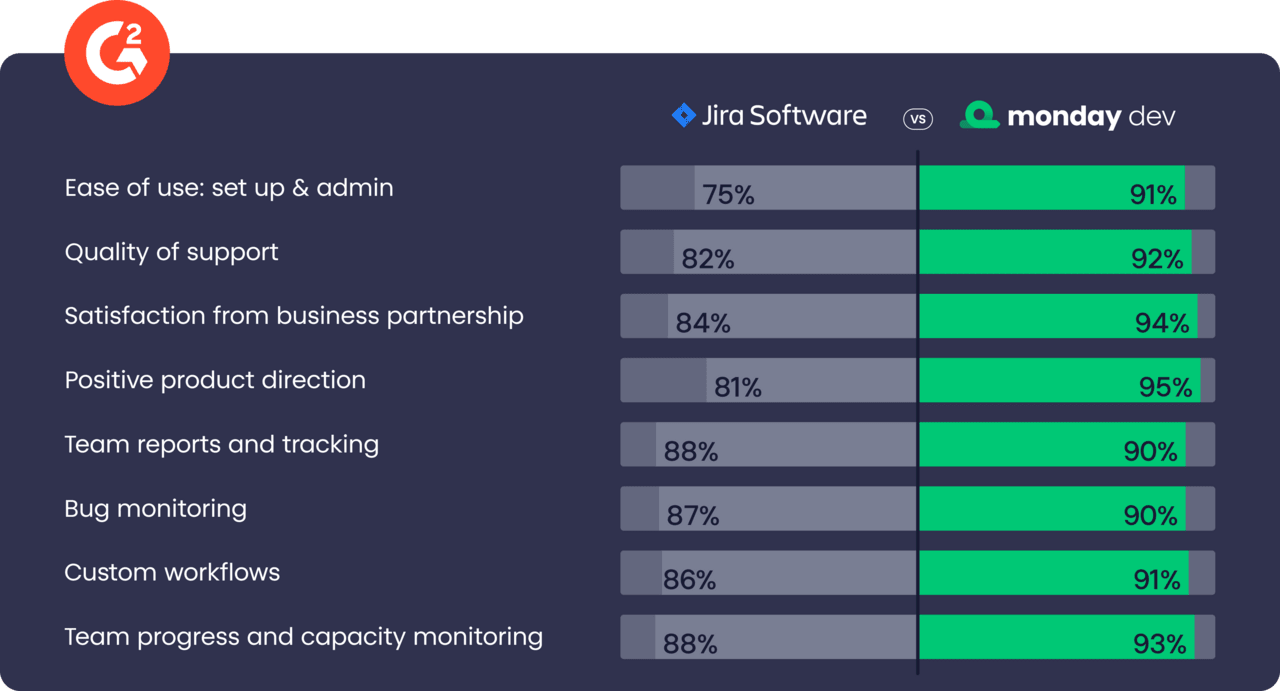
Jira, a heavyweight in the world of project management, has become synonymous with agile development. It’s the go-to solution for teams looking to streamline their workflows and keep projects on track.
Best for: Agile project management and issue tracking
Key features of Jira:
- Customizable Scrum and Kanban boards
- Advanced reporting and burndown charts
- Powerful search and filtering capabilities
- Extensive third-party app integrations
- Automated workflows and rules engine
Pros of Jira:
- Highly flexible and customizable for various team sizes and methodologies
- Robust reporting tools for data-driven decision-making
- Seamless integration with other Atlassian products
- Strong support for agile and DevOps practices
Cons of Jira:
- Can be complex to set up and administer
- User interface may feel cluttered for some users
- Potential for feature overload in smaller teams
Jira pricing:
- Free: Up to 10 users
- Standard: $7.75/seat/month
- Premium: $15.25/seat/month
- Enterprise: Custom pricing for large-scale deployments
Comparison:explore these Jira alternatives
6. Linx
Linx is a low-code development platform that’s turning heads in the backend automation space. It’s designed to help developers create custom applications and APIs with minimal hand-coding.
Best for: Rapid backend development and process automation
Key features of Linx:
- Visual designer for creating logic and workflows
- Pre-built plugins for common integrations
- RESTful and SOAP web services creation
- Automated deployment to Linx Server
- Built-in debugging and testing tools
Pros of Linx:
- Accelerates development of backend systems and APIs
- Reduces complexity in integrating disparate systems
- Lowers barrier to entry for creating robust backend solutions
- Supports both cloud and on-premises deployments
Cons of Linx:
- Learning curve for developers used to traditional coding
- Limited community support compared to open-source alternatives
- May not be suitable for highly complex, custom solutions
Linx pricing:
- Designer: Free for development and testing
- Server: Custom pricing based on deployment needs
- Contact Linx for detailed pricing information
7. Bootstrap
Bootstrap continues to be a cornerstone in responsive web design. This open-source toolkit empowers developers to create sleek, mobile-first sites with ease.
Best for: Rapid, responsive front-end development
Key features of Bootstrap:
- Responsive grid system
- Pre-styled UI components
- Customizable Sass variables and mixins
- Extensive JavaScript plugins
- Built-in icons and utilities
Pros of Bootstrap:
- Speeds up development with ready-to-use components
- Ensures consistency across projects and team members
- Highly customizable to fit brand guidelines
- Large community and extensive documentation
Cons of Bootstrap:
- Can lead to similar-looking websites if not customized
- Requires cleanup of unused CSS for optimal performance
- Learning curve for advanced customization
Bootstrap pricing:
- Free and open-source
8. Axure
Axure RP is a powerhouse for creating interactive prototypes and specifications. It bridges the gap between design and development, making it easier to visualize and test ideas before coding begins.
Best for: Advanced prototyping and UX design
Key features of Axure:
- Dynamic content simulation
- Conditional logic and complex interactions
- Collaborative team projects
- Responsive breakpoint visualization
- Built-in wireframing tools
Pros of Axure:
- Creates highly interactive prototypes without coding
- Supports complex documentation for development handoff
- Facilitates better communication between design and development teams
- Allows for rapid iteration and testing of UI/UX concepts
Cons of Axure:
- Steeper learning curve compared to simpler design tools
- Can be overkill for basic prototyping needs
- Higher price point may not be justifiable for smaller teams
Axure pricing:
- Pro: $29/seat/month (billed annually)
- Team: $49/seat/month (billed annually)
- Enterprise: Custom pricing for large organizations
9. Crimson Editor
Crimson Editor is a lightweight, yet powerful source code editor that’s been a favorite among developers for its simplicity and efficiency.
Best for: Quick code editing and scripting
Key features of Crimson Editor:
- Syntax highlighting for multiple languages
- Macro recording and playback
- File compare utility
- FTP support for remote editing
- Customizable keyboard shortcuts
Pros of Crimson Editor:
- Fast and lightweight, ideal for quick edits
- Easy to use with minimal setup required
- Supports a wide range of programming languages
- Free and open-source
Cons of Crimson Editor:
- Lacks advanced features of modern IDEs
- Limited plugin ecosystem
- Not actively developed, may lack modern language support
Crimson Editor pricing:
- Free and open-source
10. UltraEdit
UltraEdit is a versatile text editor that packs a punch with its extensive feature set, making it a go-to choice for developers who need more than just basic editing capabilities.
Best for: Advanced text editing and data manipulation
Key features of UltraEdit:
- Multi-caret editing and column mode
- Integrated FTP client
- Large file handling (4+ GB)
- Advanced find and replace with regular expressions
- Customizable UI and themes
Pros of UltraEdit:
- Powerful text manipulation tools for complex editing tasks
- Handles large files with ease
- Extensible through scripting and macros
- Regular updates and active development
Cons of UltraEdit:
- Paid software in a market with many free alternatives
- Can be resource-intensive for older systems
- Learning curve to fully utilize all features
UltraEdit pricing:
- UltraEdit: $79.95/year for a perpetual license
- UltraEdit Suite: $119.95/year for additional tools
- Volume discounts available for teams
11. Vim
Vim, the legendary text editor, continues to be a favorite among developers who prioritize efficiency and customization. Its modal editing approach offers unparalleled speed for those who master it.
Best for: Efficient text editing and programming
Key features of Vim:
- Modal editing (normal, insert, visual modes)
- Extensive plugin ecosystem
- Customizable through vimscript
- Integrated with version control systems
- Macro recording and playback
Pros of Vim:
- Extremely fast and efficient for experienced users
- Available on virtually all Unix-like systems
- Highly customizable to fit individual workflows
- Minimal resource usage, ideal for remote editing
Cons of Vim:
- Steep learning curve for newcomers
- Can be intimidating for those used to GUI editors
- Requires time investment to set up and customize effectively
Vim pricing:
- Free and open-source
12. Docker
Docker has revolutionized the way we build, ship, and run applications. By containerizing your development environment, you’re not just coding — you’re creating consistent, portable ecosystems that work seamlessly across different platforms.
Best for: Application containerization and microservices architecture
Key features of Docker:
- Container creation and management
- Docker Hub for sharing and accessing container images
- Docker Compose for multi-container applications
- Docker Swarm for container orchestration
- Integration with major cloud providers
Pros of Docker:
- Ensures consistency across development, testing, and production environments
- Simplifies deployment and scaling of applications
- Improves resource utilization compared to traditional VMs
- Extensive ecosystem and community support
Cons of Docker:
- Learning curve for teams new to containerization
- Potential security risks if not properly configured
- Performance overhead for certain types of applications
Docker pricing:
- Docker Personal: Free for individual developers
- Docker Pro: $5/seat/month
- Docker Team: $7/seat/month
- Docker Business: $21/seat/month
13. Codenvy
Codenvy, now part of Red Hat OpenShift, offers a cloud-based IDE that’s changing the game for collaborative development. It’s all about getting your team coding faster, without the hassle of local environment setup.
Best for: Cloud-based development and team collaboration
Key features of Codenvy:
- Browser-based workspaces
- Docker-powered environments
- Built-in terminal and debugger
- Team collaboration tools
- Integration with version control systems
Pros of Codenvy:
- Eliminates “works on my machine” problems
- Enables instant onboarding for new team members
- Facilitates pair programming and code reviews
- Accessible from any device with a web browser
Cons of Codenvy:
- Requires internet connection for development
- May have limitations compared to full-featured desktop IDEs
- Potential concerns about code security in cloud environments
Codenvy pricing:
- Pricing is now part of Red Hat OpenShift offerings
- Contact Red Hat for current pricing details
14. Cloud9
Amazon’s Cloud9 brings the power of cloud-based development to the AWS ecosystem. It’s not just an IDE; it’s your gateway to seamless integration with AWS services.
Best for: AWS-integrated development and serverless applications
Key features of Cloud9:
- Built-in terminal with AWS CLI
- Collaborative coding with real-time editing
- Direct deployment to AWS services
- Debugger for Node.js and Python applications
- Integrated with AWS Lambda for serverless development
Pros of Cloud9:
- Seamless integration with AWS services
- No need for local setup — code from anywhere
- Collaborative features enhance team productivity
- Pre-configured for many programming languages
Cons of Cloud9:
- Tied to the AWS ecosystem, which may not suit all projects
- Requires careful management of cloud resources to control costs
- Internet dependency can be a limitation in some scenarios
Cloud9 pricing:
- No additional charge beyond standard AWS resource costs
- Pay only for the underlying compute and storage resources used
15. SendBird
In a world where real-time communication is king, SendBird reigns supreme. This powerful chat and messaging API platform lets you build engaging in-app communication features without breaking a sweat.
Best for: Implementing real-time chat and messaging in applications
Key features of SendBird:
- Customizable UI components
- Group chat and 1-on-1 messaging
- Push notifications
- Moderation and user management tools
- Voice and video call APIs
Pros of SendBird:
- Rapid implementation of complex chat features
- Scalable infrastructure to support millions of users
- Comprehensive documentation and SDKs for major platforms
- HIPAA and GDPR compliant for secure communications
Cons of SendBird:
- Can be costly for high-volume applications
- Requires careful integration to maintain app performance
- Some advanced features may require significant customization
SendBird pricing:
- Free: Up to 100 monthly active users
- Pro: Custom pricing based on usage
- Enterprise: Tailored solutions for large-scale deployments
16. Ato
Ato is making waves in the world of AI-assisted coding. It’s not just about autocomplete — it’s about understanding your codebase and helping you write better, more efficient code.
Best for: AI-powered code completion and refactoring
Key features of Ato:
- Context-aware code suggestions
- Automated code refactoring
- Language-specific optimizations
- Integration with popular IDEs
- Continuous learning from your codebase
Pros of Ato:
- Significantly speeds up coding process
- Helps maintain consistent coding standards
- Reduces common coding errors
- Adapts to your coding style over time
Cons of Ato:
- May require time to train on larger codebases
- Potential privacy concerns with AI analysis of code
- Can be overly suggestive for experienced developers
Ato pricing:
- Free trial available
- Professional: $19/seat/month
- Team: Custom pricing for larger teams
- Enterprise: Tailored solutions with advanced features
17. Visor
Visor is reimagining project management with its unique blend of spreadsheet flexibility and Gantt chart visualization. It’s where data meets design in the world of project planning.
Best for: Visual project planning and resource management
Key features of Visor:
- Interactive Gantt charts
- Custom views (Kanban, Calendar, etc.)
- Real-time collaboration
- Automated dependency management
- Integration with popular tools (Jira, GitHub, etc.)
Pros of Visor:
- Intuitive interface combines familiarity of spreadsheets with power of project management tools
- Flexible enough to adapt to various project methodologies
- Strong visualization features aid in resource allocation and timeline management
- Facilitates better communication between technical and non-technical team members
Cons of Visor:
- May have a learning curve for teams used to traditional project management tools
- Some users report occasional performance issues with larger projects
- Limited advanced features compared to some enterprise-level solutions
Visor pricing:
- Starter: Free for up to 5 users
- Pro: $15/seat/month (billed annually)
- Enterprise: Custom pricing for large-scale deployments
18. Bitbucket
Atlassian’s Bitbucket is more than just a code repository — it’s a collaboration powerhouse for teams that live and breathe Git.
Best for: Git repository management and CI/CD pipelines
Key features of Bitbucket:
- Git repository hosting
- Built-in CI/CD with Bitbucket Pipelines
- Pull requests with inline comments
- Branch permissions and workflows
- Integration with other Atlassian products
Pros of Bitbucket:
- Seamless integration with Jira for issue tracking
- Unlimited private repositories on all plans
- Built-in CI/CD reduces need for external tools
- Flexible deployment options (cloud, server, data center)
Cons of Bitbucket:
- Less popular for open-source projects compared to GitHub
- UI can feel cluttered for some users
- Some advanced features require higher-tier plans
Bitbucket pricing:
- Free: Up to 5 users, 50 build minutes/month
- Standard: $3/seat/month, 2500 build minutes/month
- Premium: $6/seat/month, 3500 build minutes/month
- Server and Data Center options available for on-premises deployments
19. Nifty
Nifty is on a mission to unify project management, team collaboration, and client communication in one sleek package. It’s where your tasks, discussions, and documents come together seamlessly.
Best for: All-in-one project management and team collaboration
Key features of Nifty:
- Milestone-focused project planning
- Task management with Kanban and list views
- Time tracking and workload management
- Document collaboration and file sharing
- Client portals for external stakeholder involvement
Pros of Nifty:
- Intuitive interface reduces onboarding time
- Combines features of multiple tools, potentially reducing software costs
- Strong focus on visual project tracking aids in progress monitoring
- Built-in communication tools enhance team collaboration
Cons of Nifty:
- May lack some specialized features found in dedicated tools
- Some users report occasional sync issues with third-party integrations
- Advanced reporting features may be limited compared to enterprise solutions
Nifty pricing:
- Starter: $39/month for up to 10 users
- Pro: $79/month for up to 20 users
- Business: $124/month for up to 50 users
- Enterprise: Custom pricing for larger teams
20. JetBrains
JetBrains is a suite of professional-grade IDEs that cater to virtually every programming language and framework out there. It’s about coding smarter, not harder.
Best for: Language-specific intelligent coding and debugging
Key features of JetBrains:
- Intelligent code completion and refactoring
- Advanced debugging tools
- Integrated version control
- Plugin ecosystem for extended functionality
- Cross-platform compatibility
Pros of JetBrains:
- Tailored IDEs for specific languages enhance productivity
- Consistent interface across different language IDEs
- Regular updates and new feature releases
- Strong focus on code quality and best practices
Cons of JetBrains:
- Can be resource-intensive on less powerful machines
- Subscription model may be costly for individual developers
- Learning curve to fully utilize advanced features
JetBrains pricing:
- Individual IDEs: Starting from $89 for the first year
- All Products Pack: $649 for the first year (personal license)
- Team licenses available with volume discounts
- Free for students and open-source projects
Who uses software development tools?
Software development tools serve a wide range of users across various industries and organization types. Here’s a breakdown of who benefits from these powerful tools:
| User type | Examples | Needs |
|---|---|---|
| Tech-centric businesses | SMBs, mid-market businesses, startups, SaaS companies, digital agencies | Tools that support rapid development cycles, enhance collaboration, and integrate with existing tech stacks |
| Non-tech enterprises | Banks, healthcare providers, retailers | Robust, secure tools that can be easily adopted by teams with varying technical expertise |
| Educational institutions | Universities, coding boot camps, research institutions | Accessible tools that are also powerful enough for complex research and development |
| Government and Nonprofits | Government agencies, NGOs, open-source communities | Cost-effective, collaborative tools that deliver impactful results with limited resources |
| Freelancers and Independent developers | Solo entrepreneurs, freelance developers, hobbyist coders | Versatile and affordable tools that can efficiently handle various projects and client needs |
Get your products to market faster with monday dev
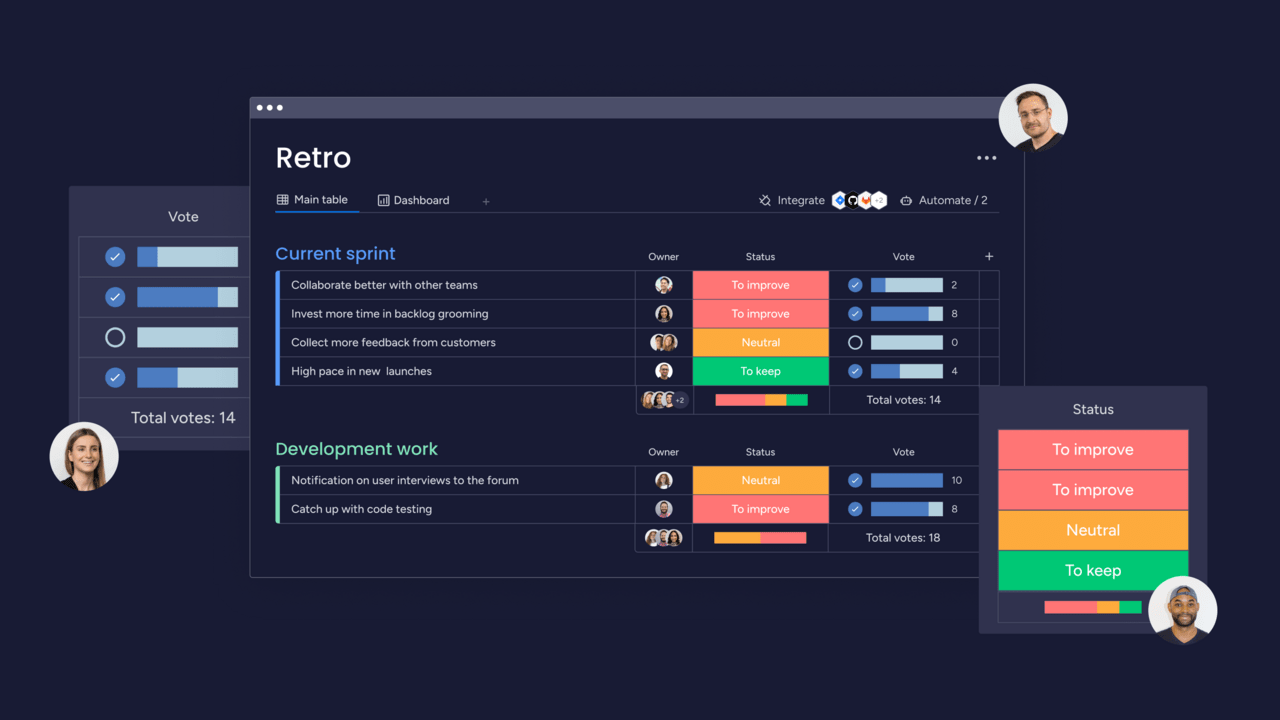
monday dev transforms how teams work together to build outstanding products. Here’s how it revolutionizes collaboration and project management across different teams:
Unified workspace
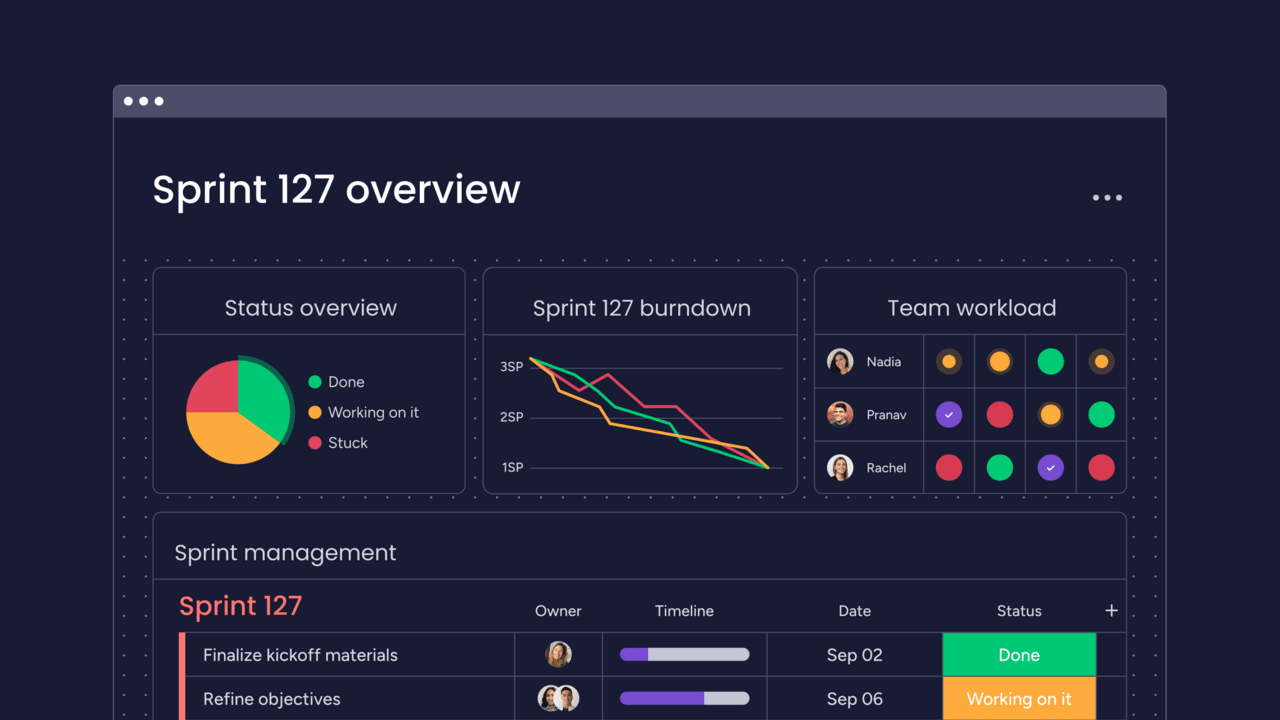
monday dev consolidates all your development processes into one intuitive platform. From sprint planning to code reviews, everything resides in a single, easily accessible location.
Visual project tracking
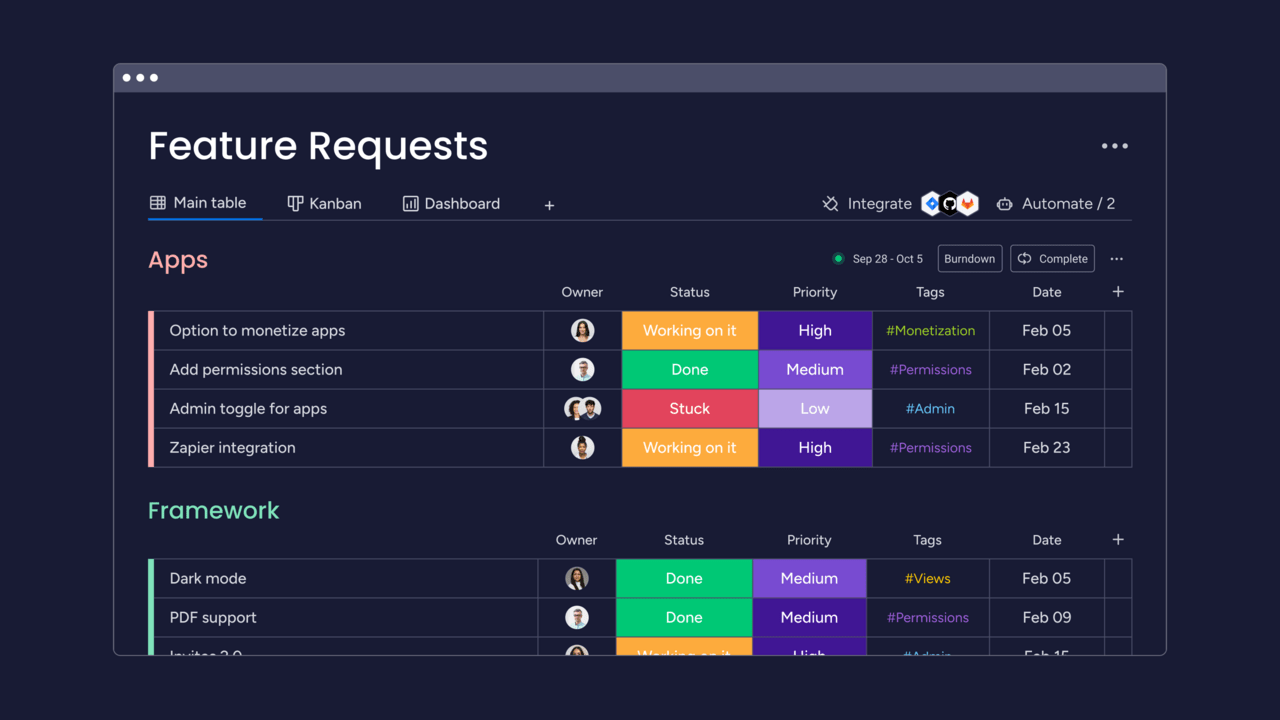
Customizable boards and timelines allow you to visualize your entire development process at a glance. Easily manage tasks, set dependencies, and monitor project progress in real-time.
Seamless integrations
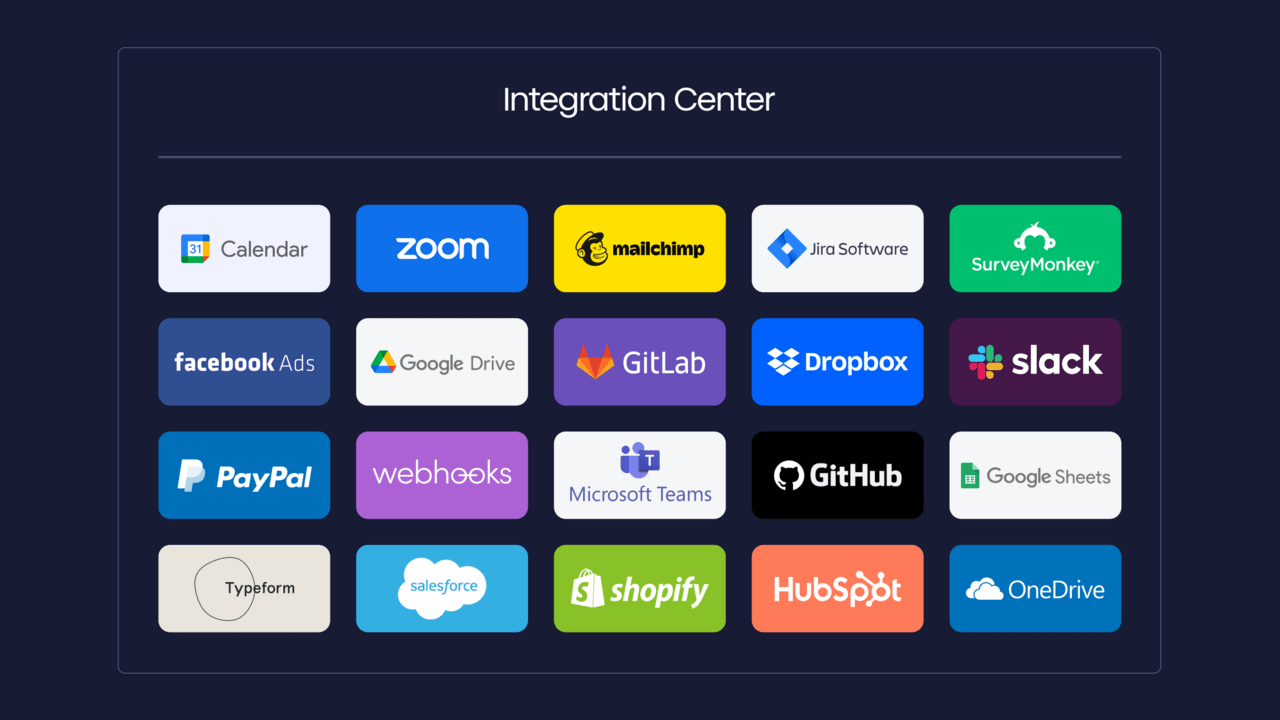
monday dev integrates smoothly with popular tools like GitHub, Jira, and Slack, creating a workflow that aligns perfectly with your team’s needs and tech stack.
Automated workflows
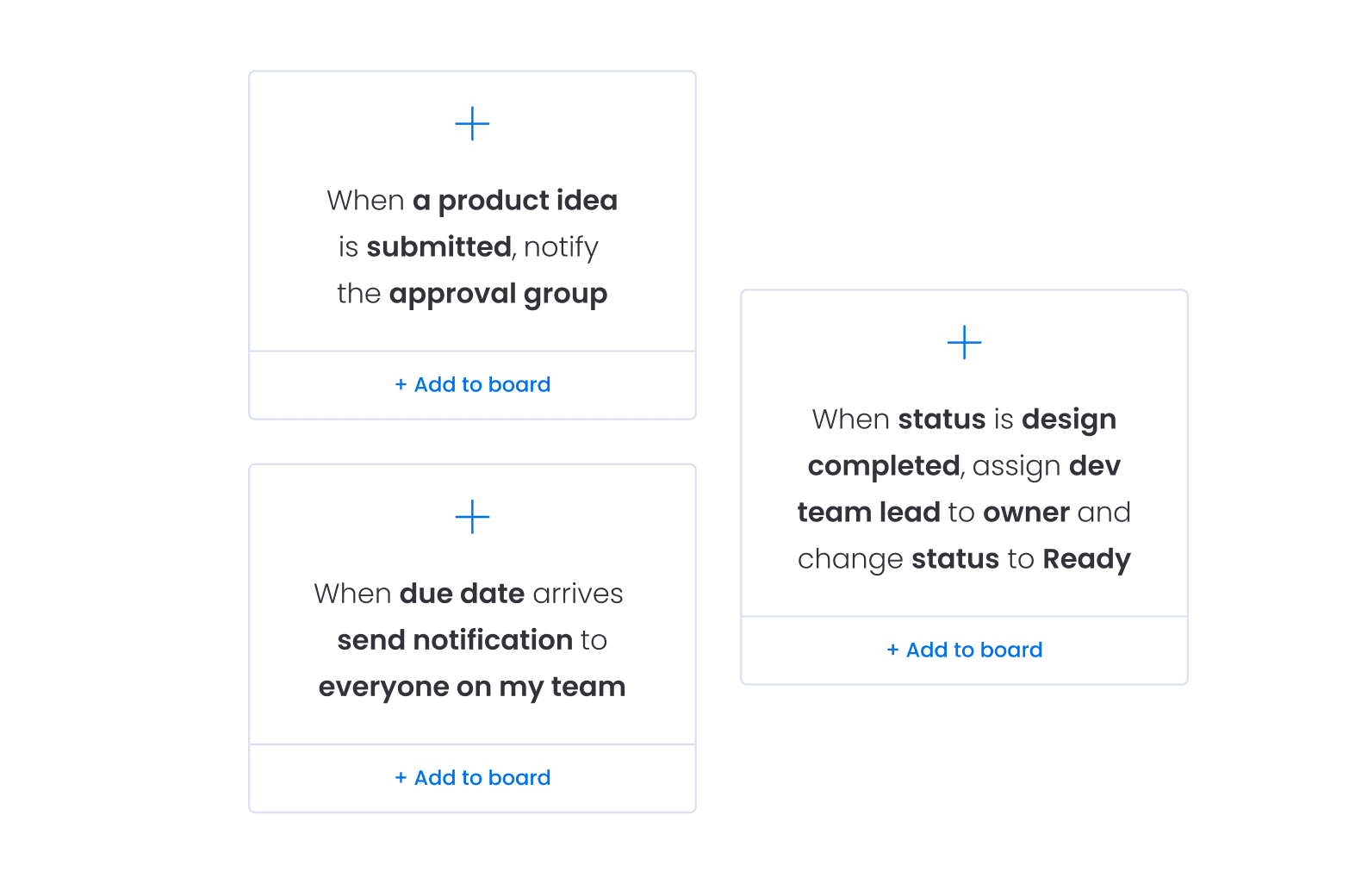
Set up automated notifications, status changes, and task assignments to keep your team focused on their core responsibility — writing great code.
Cross-functional alignment

Customizable views ensure each team member sees relevant information, promoting better understanding and collaboration across departments.
monday dev serves as the central hub for your entire development lifecycle. By unifying workflows, automating routine tasks, and promoting clear communication, it empowers your team to focus on innovation and creating impactful software.
Ready to enhance your team’s collaboration? Explore monday dev and discover how it can transform your development process. When your team works efficiently together, the possibilities are endless. Let’s create something remarkable — together.
FAQs
Which tool is best in software development?
The best tool depends on your specific needs and project type. For comprehensive project management, consider platforms like monday dev. For version control, GitHub or Bitbucket are popular. IDEs like Visual Studio Code excel in coding. Often, a combination of tools creates the most effective development environment.
What should I look for in a software development tool?
Key factors include ease of use, integration capabilities, scalability, collaboration features, customization options, and security measures. Look for tools that align with your workflow, offer regular updates, and provide strong customer support. The ideal tool should enhance productivity without a steep learning curve.
How do software development tools improve team collaboration?
These tools enhance collaboration by providing centralized platforms for project management and communication. They enable real-time interactions, facilitate code reviews, and create transparency in project progress. By automating workflows and offering version control, they reduce miscommunication and streamline processes, allowing teams to work efficiently regardless of location.
Can software development tools be customized to fit specific project needs?
Yes, most modern tools offer extensive customization. For example, monday dev provides customizable boards and views, flexible column types, and automation recipes. Many tools allow API access for custom integrations and the ability to create templates for different project types. This flexibility ensures the tool adapts to your processes, not vice versa.
 Get started
Get started 
